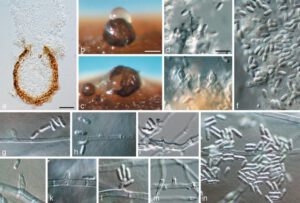Celerioriella dura (Damm & Crous) Crous, Persoonia 34: 227 (2015)
Index Fungorum Number: IF 812478; MycoBank Number: MB 812478; Facesoffungi Number: FoF 15737
Basionym: Phaeomoniella dura Damm & Crous, Persoonia 24: 73. 2010.
Etymology – Named after the tough mycelium (durus Lat. = tough).
Vegetative hyphae hyaline, 1–2.5 μm wide, smooth-walled, lacking chlamydospores; mycelium on PDA tough, leathery. Sporulation abundant; conidia formed on hyphal cells and in pycnidia. Conidiophores on hyphae often reduced to conidiogenous cells; if not, then 2–3-celled, unbranched, 10–20 × 1.5 μm. Conidiogenous cells enteroblastic, rarely occurring as discrete phialides, mostly reduced to adelophialides or more often with collarettes formed directly on hyphal cells; collarettes distinct, cylindrical, 0.5–1 long, opening 0.5 μm wide, with cylindrical to conical necks, 1–2 × 1–2 μm; discrete phialides cylindrical to subcylindrical, sometimes constricted at the base, 5–7 × 1–1.5 μm. Conidia aggregated in masses around the hyphae, hyaline, 1-celled, sometimes septate when very large, cylindrical, with one end obtuse and the other end attenuated; smooth-walled, sometimes biguttulate with tiny droplets, 3–6(–10) × 1–2(–3) μm, mean ± SD = 4.5 ± 1.3 × 1.3 ± 0.5 μm, L/W ratio = 3.5. Microcyclic conidial formation rare. Conidiomata pycnidial, produced on pine needles on SNA and on MEA in 2–4 wk; on pine needles solitary, subglobose, superficial, 50–240 μm wide, unilocular, opening by irregular rupture, with wall composed of brown textura angularis. Conidiophores hyaline, branched and septate. Conidiogenous cells enteroblastic, hyaline, consisting of discrete phialides that are ampulliform to conical, 3–6 × 2–4 μm; with cylindrical collarettes, 0.5–1 μm long, opening 0.5–1 μm. Conidia hyaline, 1-celled, cylindrical, sometimes slightly curved, with both ends obtuse, smooth-walled, sometimes biguttulate with tiny droplets, (2.5–)3–3.5(–4) × 1(–1.5) μm, mean ± SD = 3.1 ± 0.3 × 1.1 ± 0.1 μm, L/W ratio = 2.9.
Culture characteristics — Colonies on PDA flat, moist to slimy, folded towards the centre, with entire margin and sparse, villose, white, aerial mycelium; surface white to pale buff with tiny black spots, sometimes pale honey at centre; on MEA flat, folded towards the centre, with undulate margin, grey-olivaceous with tiny black spots towards the centre, buff at the margin; 20 mm in diam after 2 wk (25 °C dark), min 5 °C, max 30 °C, opt 20 °C.
Specimen examined – South Africa, Limpopo Province, Mookgopong, from necrosis in wood of P. salicina, 31 Aug. 2004, U. Damm, CBS H-19999 holotype, culture ex-type CBS 120882 = STE-U 6122.

Figure 1 –Celerioriella dura. a. Longitudinal section through a pycnidium; b, c. conidia oozing from pycnidium on pine needle; d, e. conidiogenous cells lining the inner wall of pycnidia; f. conidia formed in pycnidia; g–m. conidiogenous cells on hyphal cells; n. conidia formed on hyphal cells. All from ex-type culture CBS 120882. a, d–n: DIC; b, c: DM. — Scale bars: a = 20 μm; b = 100 μm; d = 5 μm; b applies to b, c; d applies to d–n.
